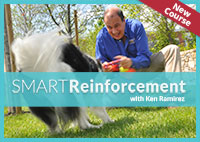Why does clicker training work?
- Clicker training uses a distinct and consistent signal to mark a desired behavior in real time and then follows that signal with a motivating reward. Because animals understand precisely which action earned the click and their reward, they learn new behaviors quickly, easily, and enthusiastically.
Why is clicker training better than just using my voice, positive attention, praise, food, or other training methods?

- Lots of important reasons. The click pinpoints the behavior exactly so your dog will learn desirable behavior amazingly quickly—often from one, two, or three clicks. The clicker provides a consistent, non-emotional marker so your dog always receives the same information. The clicker is also distinct from other signals in the environment.
- Basic obedience, good manners and fun games can be easily self taught even in busy family households, where time is short and schedules hectic.
- Training can be woven into daily activities including walking to school, making dinner, or even watching TV
- Everyone in the family—children and adults—can participate and share in the fun both with puppies and adult dogs
- Breeders can raise puppies that are already "clickerwise" and home-ready
The information the click provides is retained. Behavior is remembered from one training session to the next, so training sessions can be short and flexibly designed. Also, unlike word cues, clicker training does not convey emotionally loaded approval or disapproval to the animal—it is simply information the dog can use to earn a reward or try again.
And because clicker training doesn't rely on punishment, force, aversive methods, sprays, or choke collars to get results, it is the only method of training we know of that is safely and effectively used with puppies even weeks old. As a result:
Read more about just using your voice.
What results should I expect and when?
- We often talk about the "lightbulb moment." It is the moment when your dog and you connect through the sound of the clicker. Communication has been established and it is as exciting for the animal as it is for the trainer. Most dogs will have the lightbulb moment—you can see it in their eyes—in lesson one! Teaching fun but simple behaviors like shaking hands or coming when called can be accomplished in one or two sessions. More complex behaviors can be trained a piece at a time, building or shaping the action over a series of sessions. For example, teaching your dog to "Find the Remote Control to Your TV" may take a several sessions, yet each session will only be 5-15 minutes long!
Do I have to continue clicking and treating forever?
- No. Clicker training is used to teach/learn new behaviors. Once the behavior is learned, the clicker isn't needed any more for that behavior—although praise and treats will always be appreciated. Whenever you want to train a new behavior, or fine-tune an old one, use the clicker.
Is a lot of experience required to clicker train successfully?
- Absolutely not. (Sometimes it even gets in the way.) Clicker training is easy to learn with the right instructions—either from one of our products or from an experienced clicker trainer. A part of clicker training that may take some practice is timing the clicks to capture the exact behavior you are seeking. But don't worry, clicker training is so forgiving and so much fun for everyone that you don't have to worry about mistakes. They won't interfere with training in the long run.
Will clicker training work with my dog?
- Yes. Clicker training works with all breeds, all ages, all types of dogs, purebred and rescue, champions and house companions. With deaf dogs, substitute a light flash for the clicker.
My dog isn't food motivated, what do I do?
- Food is the most popular reward, but anything your dog loves can be used as a reward. Throwing a tennis ball or a quick game of tug are both highly motivating rewards.
- If you would like to use food treats, be sure that your tidbits are especially yummy (bits of hotdogs, for example) and that your dog's meals do not immediately precede a training session.
Won't my dog get fat if I feed him every time I train him?
- No. Tiny amounts pieces of food are used a treats. Small is important because you want your dog to be able to eat it and be "ready to play clicker" some more. Clicker training is also good exercise and highly stimulating. Dogs work when they clicker train! You may also wish to substitute a clicker session for one of your dog's regular mealtimes.
Can a dog that has been trained " traditionally" be "crossed over" to clicker training?
- Absolutely. Crossover trainers are often amazed at the change that comes over their dogs when they switch to clicker training. Previously hesitant and shy dogs become enthusiastic and creative learners. To try clicker training with a dog previously trained with traditional methods, don't begin with a behavior the dog already knows—try something completely new and fun.
Can I clicker train the dog I rescued from a humane organization?
- Yes! Most dogs are surrendered to shelters for behavioral issues. Clicker training is a fast, humane, and enriching way of integrating your pet into a new home and fixing or avoiding behavioral problems.
What about aggressive behavior?
- Clicker training can be highly effective in calming aggression and giving a fearful dog confidence. Click to Calm: Healing the Aggressive Dog by Emma Parsons (KPCT: 2005) is packed with innovative and simple solutions for helping any dog to change its patterns of aggressive behavior with a clicker and positive reinforcement.
My trainer or vet doesn't use clicker training, but others I know do use it. If clicker training is so great, why isn't it universally practiced?
- We wish it were! Real change takes time…and then some. If a trainer or a vet you know doesn't clicker training it is probably because they haven't had much exposure and/or they feel their existing methods for training or curing behavior problems work well enough already.
Karen Pryor has been clicker training or using "operant conditioning" with animals since her days as a dolphin trainer in the 1960s. New ideas usually take time to work their way fully into acceptance. (As an example, Karen also wrote a landmark book in 1963, Nursing Your Baby, which advocated breastfeeding babies in an era when most babies were formula-fed. While her book soon became a classic and helped turn the tide of attitudes toward breastfeeding, there still remains some resistance to breastfeeding.)
We believe in "changing the world one click at a time" because it is only by experiencing clicker training themselves that people who care about animals will realize its full potential. More and more trainers are using clicker training to teach basic obedience and other classes, more shelters are using it to care for animals, and more vets are recommending it.
What's the origin of clicker training?
- Read about the History of Clicker Training.






